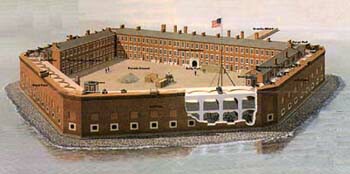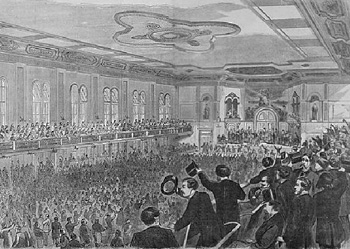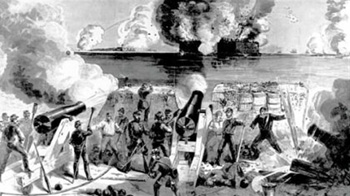Book reviews
 |
 |
 |
 |
 |
 |
 |
An Episode Revealing ‘Dishonest Abe’
Book review of The North, the South and Lincoln’s War Policies, Book III, by Adam S. Miller, Monrovia, MD: Tower of David/Marian Pub., Inc., 2015, 196 pp.
With the election of the radically pro-North Abraham Lincoln in November 1860, many in the South concluded that they could no longer rely on the Federal Government to protect their interests. The republican-led North, determined to dominate and exploit the South, now held complete sway over each branch of the Federal Government. In recognition of this threat, several States in the South, led by South Carolina, began to secede, coordinating to form their own government, the Confederate States of America.
As the South left the Union most of the militia units retained their loyalties to their State. A few units of federal soldiers, however, were stationed in the South and this quickly gave margin to a very dangerous controversy.
While President Buchanan – Lincoln’s predecessor – was making conciliatory promises towards the South, he secretly corresponded with soldiers stationed in South Carolina. In late December approximately 80 federal soldiers, under cover of night, left the Southern fort they were originally stationed at and occupied the more defensible Fort Sumter that rested on an island in the bay of Charleston Harbor, South Carolina.
This action, implicitly supported by the Federal Government, precipitated a reaction by the South: An uneasy siege of Fort Sumter made by Southern forces took place, with neither side firing willing to fire the first shots. Soon, this situation at Fort Sumter would escalate and be used by the North as casus belli [motive for a war].
In the third volume of his series Adam Miller analyses the wartime policies of Lincoln and his administration as well as the conflict itself. This terrible war - which resulted in more American casualties than nearly every other American war combined, wreaked unimaginable catastrophe on the South, established a colossal and despotic Federal Government and set the tone for the relation between State and Federal Government down to our very day - can well be said to be one of the most influential events in American History. The books presentation of Lincoln’s is significantly different from that portrayed in our conventional history texts and undermines the popular myths surrounding this most revered figure.
Fort Sumter
When Abraham Lincoln took office in January of 1861, he inherited the Fort Sumter crisis. For months federal soldiers had held Fort Sumter. Already one disguised supply ship had tried to deliver soldiers and ammunition to the Fort, but had been turned back by Southern warning shots. This attempt to give logistic support to those soldiers was a blatant violation of promises made towards the South. Lincoln would prove himself no more honest.
 To bring the Fort Sumter affair to a peaceful conclusion, several prominent Southern commissioners were dispatched to Washington D.C. with due juridical evidence of State ownership of the Fort and a genuine desire to arrive at a peaceful outcome. Indeed, several state ordinances passed in 1805 stipulated that ownership of such properties was only ceded to the government under highly specific conditions. Additionally, under Lincoln’s predecessor an armistice had been signed between the Federal Government and the seceded State of South Carolina agreeing that such Fort would not be reinforced.
To bring the Fort Sumter affair to a peaceful conclusion, several prominent Southern commissioners were dispatched to Washington D.C. with due juridical evidence of State ownership of the Fort and a genuine desire to arrive at a peaceful outcome. Indeed, several state ordinances passed in 1805 stipulated that ownership of such properties was only ceded to the government under highly specific conditions. Additionally, under Lincoln’s predecessor an armistice had been signed between the Federal Government and the seceded State of South Carolina agreeing that such Fort would not be reinforced.
This agreement had already been violated twice by the North when federal soldiers took Fort Sumter and, again, when the North attempted to land an additional reinforcement of 200 men. But the South so keenly desired peaceful secession that it was willing to give Lincoln a trust of good faith. Despite these peaceful overtures, Lincoln dealt with the commissioners and their juridical evidence by ignoring them, attesting both to his dishonest shrewdness and his commitment to instigate a conflict.
The good-willed Southern commissioners were left waiting for a month on vague promises of a hearing and were even assured that they would be informed of any military movements. These delays were made to buy time for Lincoln and his staff to arrange for their real plan for the Fort. Finally, the commissioners were forced to give up in mid-April as the military conflict began. This diplomatic dishonesty alone should be enough to undermine Lincoln’s reputation. But his acts of deceit went further…
Dishonest Abe & the first shots
While the Southern commissioners were still waiting in good faith to be heard, Lincoln and his administration set in motion more plans that would escalate the situation and force the South’s hand. A military convoy of 12 ships, outfitted with supplies, ammunition, 2400 soldiers and 230 heavy cannons, was sent from Northern ports to rendezvous off the coast of Fort Sumter. An invasion fleet had been dispatched.
 The Confederacy had already intercepted several messages proving that Lincoln’s peace envoys sent to discuss the “evacuation” of the Fort were in reality attempting to organize its reinforcement. With that and other intelligence, the South knew that Lincoln had committed blatant deception and that an armed fleet was on its way.
On April 12, as the Northern invasion fleet, filled with guns and men, assembled in Confederate waters and the last plea for the Fort to be evacuated was put off, Confederate forces deemed that they had no option but to open fire on Fort Sumter, the foothold of the Northern army.
The Confederacy had already intercepted several messages proving that Lincoln’s peace envoys sent to discuss the “evacuation” of the Fort were in reality attempting to organize its reinforcement. With that and other intelligence, the South knew that Lincoln had committed blatant deception and that an armed fleet was on its way.
On April 12, as the Northern invasion fleet, filled with guns and men, assembled in Confederate waters and the last plea for the Fort to be evacuated was put off, Confederate forces deemed that they had no option but to open fire on Fort Sumter, the foothold of the Northern army.
Cannons roared, but strangely the fleet stayed anchored outside the harbor, offering no assistance to the desperate Fort. The next day, the Confederate general – seeing that the Northern fleet was offering no assistance to the Fort – ceased fire and once more asked the Fort to surrender. The Northern commander, seeing that he was receiving no help from his promised reinforcements, accepted. In one of history’s strange ironies not a soldier died during this exchange of fire. The bloodiest war in American History opened with a “battle” wherein no blood was shed.
Abraham Lincoln’s sending an armed fleet into Southern waters to reinforce a Fort illegally held by the federal military can only be construed as an act of war. Though the fleet did not engage in combat and, eventually, turned back without even picking up the men who surrendered at Fort Sumter, it does not change the fact that it was an armed fleet that had entered Southern waters with overtly hostile intentions.
 Any such action performed by one country against another easily classifies as an act of war itself, regardless of whether the fleet actually fights. A man who puts a loaded gun to another’s head does not need to fire first for his target to have a right to defend himself.
Any such action performed by one country against another easily classifies as an act of war itself, regardless of whether the fleet actually fights. A man who puts a loaded gun to another’s head does not need to fire first for his target to have a right to defend himself.
Yet, the South, which was in truth reacting to an invasion, is vilified in history books as having been the aggressor, alleging that from the South were the first shots fired. Several European newspapers recognized the incident to be a duplicitous ploy intended to give Lincoln and his cabinet a casus belli.
Even before this, in January of 1861, Northern soldiers had opened fire upon confederate forces at Fort Pickens, Florida, an act of war that is simply omitted from most history books that favor depicting the South as the aggressor.
Thus, Miller demonstrates that the true circumstances surrounding the opening of hostilities are warped and distorted and that our history texts fail to acknowledge Lincoln’s wholesale deception towards the South. Instead, American History, here so clearly written by the winners, sees the South as the aggressor and Lincoln as the great “Honest Abe.” The opening of the war should show, if anything, that right from the outset Lincoln was anything but honest.
Continued

As the South left the Union most of the militia units retained their loyalties to their State. A few units of federal soldiers, however, were stationed in the South and this quickly gave margin to a very dangerous controversy.
While President Buchanan – Lincoln’s predecessor – was making conciliatory promises towards the South, he secretly corresponded with soldiers stationed in South Carolina. In late December approximately 80 federal soldiers, under cover of night, left the Southern fort they were originally stationed at and occupied the more defensible Fort Sumter that rested on an island in the bay of Charleston Harbor, South Carolina.
This action, implicitly supported by the Federal Government, precipitated a reaction by the South: An uneasy siege of Fort Sumter made by Southern forces took place, with neither side firing willing to fire the first shots. Soon, this situation at Fort Sumter would escalate and be used by the North as casus belli [motive for a war].
In the third volume of his series Adam Miller analyses the wartime policies of Lincoln and his administration as well as the conflict itself. This terrible war - which resulted in more American casualties than nearly every other American war combined, wreaked unimaginable catastrophe on the South, established a colossal and despotic Federal Government and set the tone for the relation between State and Federal Government down to our very day - can well be said to be one of the most influential events in American History. The books presentation of Lincoln’s is significantly different from that portrayed in our conventional history texts and undermines the popular myths surrounding this most revered figure.
Fort Sumter
When Abraham Lincoln took office in January of 1861, he inherited the Fort Sumter crisis. For months federal soldiers had held Fort Sumter. Already one disguised supply ship had tried to deliver soldiers and ammunition to the Fort, but had been turned back by Southern warning shots. This attempt to give logistic support to those soldiers was a blatant violation of promises made towards the South. Lincoln would prove himself no more honest.

Fort Sumter
This agreement had already been violated twice by the North when federal soldiers took Fort Sumter and, again, when the North attempted to land an additional reinforcement of 200 men. But the South so keenly desired peaceful secession that it was willing to give Lincoln a trust of good faith. Despite these peaceful overtures, Lincoln dealt with the commissioners and their juridical evidence by ignoring them, attesting both to his dishonest shrewdness and his commitment to instigate a conflict.
The good-willed Southern commissioners were left waiting for a month on vague promises of a hearing and were even assured that they would be informed of any military movements. These delays were made to buy time for Lincoln and his staff to arrange for their real plan for the Fort. Finally, the commissioners were forced to give up in mid-April as the military conflict began. This diplomatic dishonesty alone should be enough to undermine Lincoln’s reputation. But his acts of deceit went further…
Dishonest Abe & the first shots
While the Southern commissioners were still waiting in good faith to be heard, Lincoln and his administration set in motion more plans that would escalate the situation and force the South’s hand. A military convoy of 12 ships, outfitted with supplies, ammunition, 2400 soldiers and 230 heavy cannons, was sent from Northern ports to rendezvous off the coast of Fort Sumter. An invasion fleet had been dispatched.

The delegates of South Carolina vote for secession in December 1860
Cannons roared, but strangely the fleet stayed anchored outside the harbor, offering no assistance to the desperate Fort. The next day, the Confederate general – seeing that the Northern fleet was offering no assistance to the Fort – ceased fire and once more asked the Fort to surrender. The Northern commander, seeing that he was receiving no help from his promised reinforcements, accepted. In one of history’s strange ironies not a soldier died during this exchange of fire. The bloodiest war in American History opened with a “battle” wherein no blood was shed.
Abraham Lincoln’s sending an armed fleet into Southern waters to reinforce a Fort illegally held by the federal military can only be construed as an act of war. Though the fleet did not engage in combat and, eventually, turned back without even picking up the men who surrendered at Fort Sumter, it does not change the fact that it was an armed fleet that had entered Southern waters with overtly hostile intentions.

In the Battle of Fort Sumter – in the background – both sides shot and no one died
Yet, the South, which was in truth reacting to an invasion, is vilified in history books as having been the aggressor, alleging that from the South were the first shots fired. Several European newspapers recognized the incident to be a duplicitous ploy intended to give Lincoln and his cabinet a casus belli.
Even before this, in January of 1861, Northern soldiers had opened fire upon confederate forces at Fort Pickens, Florida, an act of war that is simply omitted from most history books that favor depicting the South as the aggressor.
Thus, Miller demonstrates that the true circumstances surrounding the opening of hostilities are warped and distorted and that our history texts fail to acknowledge Lincoln’s wholesale deception towards the South. Instead, American History, here so clearly written by the winners, sees the South as the aggressor and Lincoln as the great “Honest Abe.” The opening of the war should show, if anything, that right from the outset Lincoln was anything but honest.
Continued

Posted May 20, 2016
______________________
______________________
 Volume I |
 Volume II |
 Volume III |
 Volume IV |
 Volume V |
 Volume VI |
 Volume VII |
 Volume VIII |
 Volume IX |
 Volume XI |
 Special Edition |
 Special Edition |



